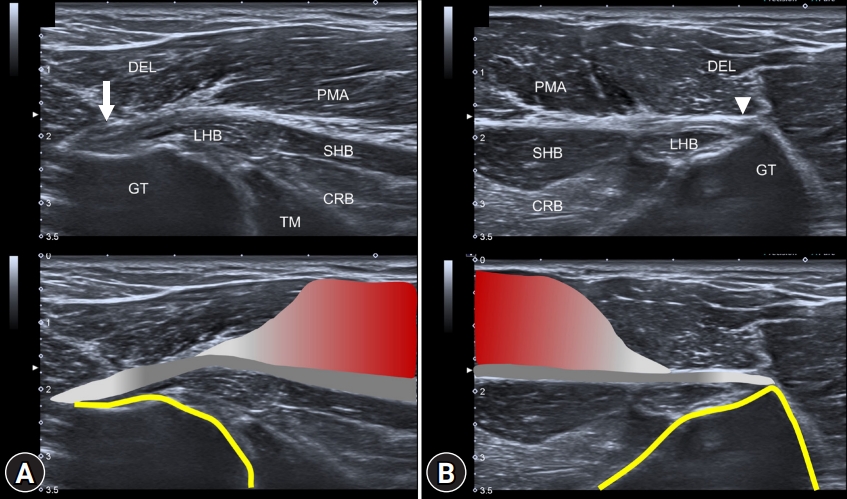PubMed Central, CAS, DOAJ, KCI

Articles
- Page Path
- HOME > J Yeungnam Med Sci > Volume 40(1); 2023 > Article
-
Resident fellow section: Teaching images
Right arm pain after strength training: ultrasound imaging for pectoralis major tendon strain -
Ting-Yu Lin1
 , Ke-Vin Chang2,3,4
, Ke-Vin Chang2,3,4 , Wei-Ting Wu2,3
, Wei-Ting Wu2,3 , Levent Özçakar5
, Levent Özçakar5
-
Journal of Yeungnam Medical Science 2023;40(1):109-111.
DOI: https://doi.org/10.12701/jyms.2022.00626
Published online: October 25, 2022
1Department of Physical Medicine and Rehabilitation, Lo-Hsu Medical Foundation, Inc., Lotung Poh-Ai Hospital, Yilan, Taiwan
2Department of Physical Medicine and Rehabilitation, National Taiwan University Hospital and National Taiwan University College of Medicine, Taipei, Taiwan
3Department of Physical Medicine and Rehabilitation, Bei-Hu Branch of National Taiwan University Hospital, Taipei, Taiwan
4Center for Regional Anesthesia and Pain Medicine, Wang-Fang Hospital, Taipei Medical University, Taipei, Taiwan
5Department of Physical and Rehabilitation Medicine, Hacettepe University Medical School, Ankara, Turkey
- Corresponding author: Ke-Vin Chang, MD, PhD Department of Physical Medicine and Rehabilitation, Bei-Hu Branch of National Taiwan University Hospital, National Taiwan University College of Medicine, No. 7, Zhongshan S. Rd., Zhongzheng Dist., Taipei 100225, Taiwan Tel: +886-2-2312-3456 • E-mail: kvchang011@gmail.com
Copyright © 2023 Yeungnam University College of Medicine, Yeungnam University Institute of Medical Science
This is an Open Access article distributed under the terms of the Creative Commons Attribution Non-Commercial License (http://creativecommons.org/licenses/by-nc/4.0/) which permits unrestricted non-commercial use, distribution, and reproduction in any medium, provided the original work is properly cited.
- • Pectoralis major injuries mostly occur during strength training when forceful eccentric contraction is performed with shoulder abduction and external rotation.
- • Ultrasound examination for pectoralis major injuries should encompass the entire muscle, but especially focusing on the musculotendinous junction and humeral insertion.
- • Conservative treatment is indicated when the tear is partial, located inside the muscle belly, or observed in a sedentary patient who is elderly. Otherwise, surgical referral is suggested.
Learning points
-
Ethical statements
Written patient consent was obtained for the publication of this report.
-
Conflicts of interest
Ke-Vin Chang and Wei-Ting Wu have been editorial board member of Journal of Yeungnam Medical Science (JYMS) since 2021. He was not involved in the review process of this manuscript. Otherwise, there is no conflict of interest to declare.
-
Funding
This work was funded by National Taiwan University Hospital, Bei-Hu Branch; Ministry of Science and Technology (MOST 106-2314-B-002-180-MY3 and 109-2314-B-002-114-MY3); and the Taiwan Society of Ultrasound in Medicine.
-
Author contributions
Conceptualization, Funding acquisition: KVC, WTW, LÖ; Investigation: KVC; Validation: WTW, LÖ; Writing-original draft: TYL; Writing-review & editing: KVC, LÖ.
Notes

- 1. Chang KV, Lin CP, Lin CS, Wu WT, Özçakar L. A novel approach for ultrasound guided axillary nerve block: the inferior axilla technique. Med Ultrason 2017;19:457–61.ArticlePDF
- 2. Butt U, Mehta S, Funk L, Monga P. Pectoralis major ruptures: a review of current management. J Shoulder Elbow Surg 2015;24:655–62.ArticlePubMed
- 3. Fung L, Wong B, Ravichandiran K, Agur A, Rindlisbacher T, Elmaraghy A. Three-dimensional study of pectoralis major muscle and tendon architecture. Clin Anat 2009;22:500–8.ArticlePubMed
- 4. ElMaraghy AW, Devereaux MW. A systematic review and comprehensive classification of pectoralis major tears. J Shoulder Elbow Surg 2012;21:412–22.ArticlePubMed
- 5. Chiavaras MM, Jacobson JA, Smith J, Dahm DL. Pectoralis major tears: anatomy, classification, and diagnosis with ultrasound and MR imaging. Skeletal Radiol 2015;44:157–64.ArticlePubMedPDF
- 6. Petilon J, Carr DR, Sekiya JK, Unger DV. Pectoralis major muscle injuries: evaluation and management. J Am Acad Orthop Surg 2005;13:59–68.ArticlePubMed
- 7. Chang KV, Wur WT, Özçakar L. Ultrasound imaging and rehabilitation of muscle disorders: part 1. Traumatic Injuries. Am J Phys Med Rehabil 2019;98:1133–41.ArticlePubMed
- 8. Lee SJ, Jacobson JA, Kim SM, Fessell D, Jiang Y, Girish G, et al. Distal pectoralis major tears: sonographic characterization and potential diagnostic pitfalls. J Ultrasound Med 2013;32:2075–81.ArticlePubMed
References
Figure & Data
References
Citations

- MSK Ultrasound: A Powerful Tool for Evaluating and Diagnosing Pectoralis Major Injuries in Healthcare Practice
Robert C. Manske, Chris Wolfe, Phil Page, Michael Voight
International Journal of Sports Physical Therapy.2024;[Epub] CrossRef

 E-Submission
E-Submission Yeungnam University College of Medicine
Yeungnam University College of Medicine PubReader
PubReader ePub Link
ePub Link Cite
Cite


